Business Research Report: Challenges in Cyber Security
VerifiedAdded on 2021/06/14
|12
|3221
|498
Report
AI Summary
This report provides a comprehensive overview of the significant challenges businesses face in the realm of cyber security. It delves into the importance of cyber security in protecting data integrity and confidentiality, particularly in the context of rapid technological advancements and the increasing sophistication of cyber threats. The report outlines the project objectives and scope, which focus on identifying and analyzing various cyber security challenges and associated risks. It reviews existing literature to highlight key issues such as data modification, denial of service attacks, malware, and the vulnerabilities introduced by mobile technology and third-party vendors. The report also discusses the impact of these challenges on businesses, including financial losses, reputational damage, and the need for robust security measures. Furthermore, it emphasizes the importance of proactive strategies to mitigate risks and protect business assets in an increasingly interconnected digital landscape. The report highlights the need for businesses to adopt comprehensive cyber security practices and stay informed about emerging threats to safeguard their operations and maintain customer trust.
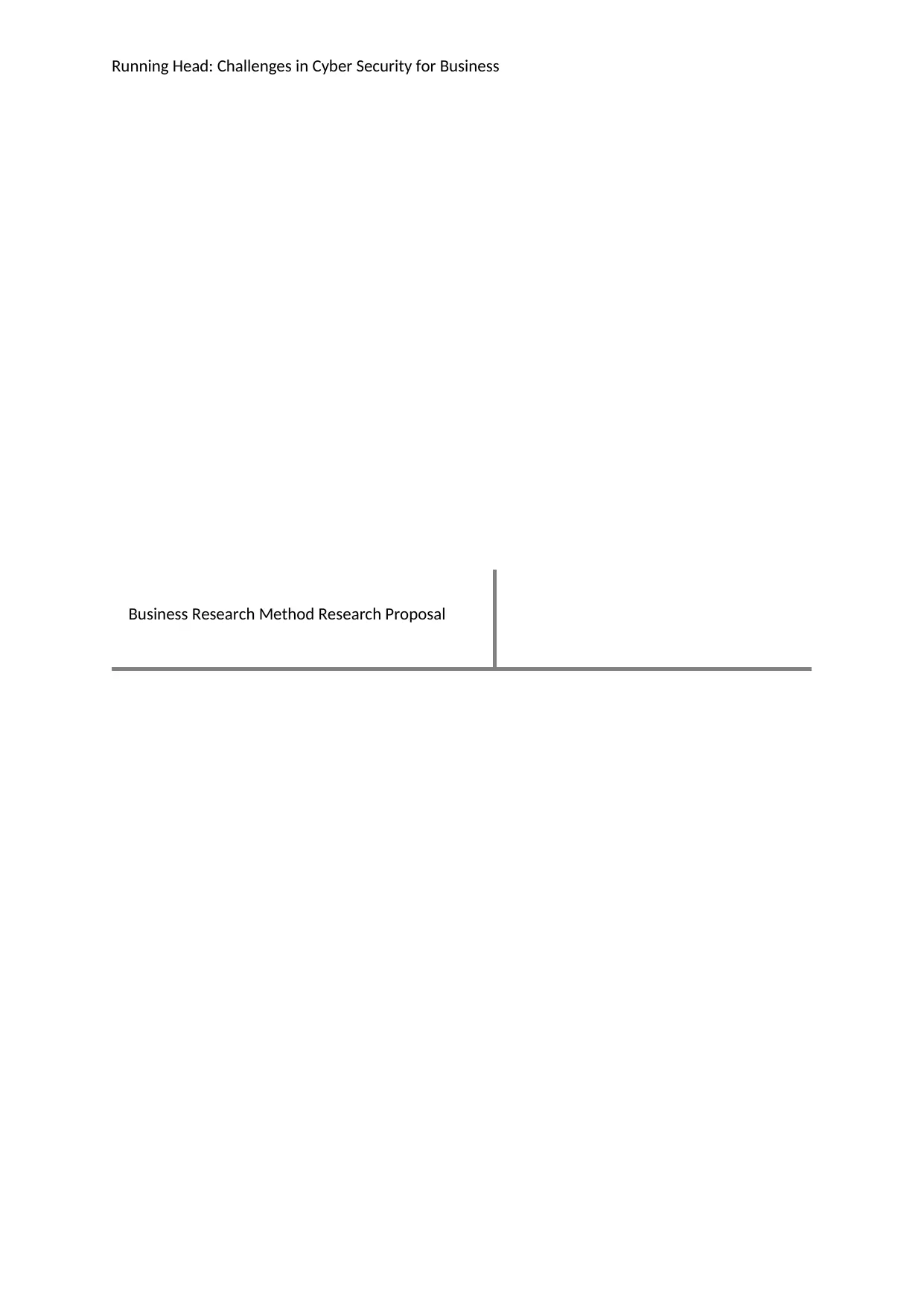
Running Head: Challenges in Cyber Security for Business
Business Research Method Research Proposal
Business Research Method Research Proposal
Paraphrase This Document
Need a fresh take? Get an instant paraphrase of this document with our AI Paraphraser
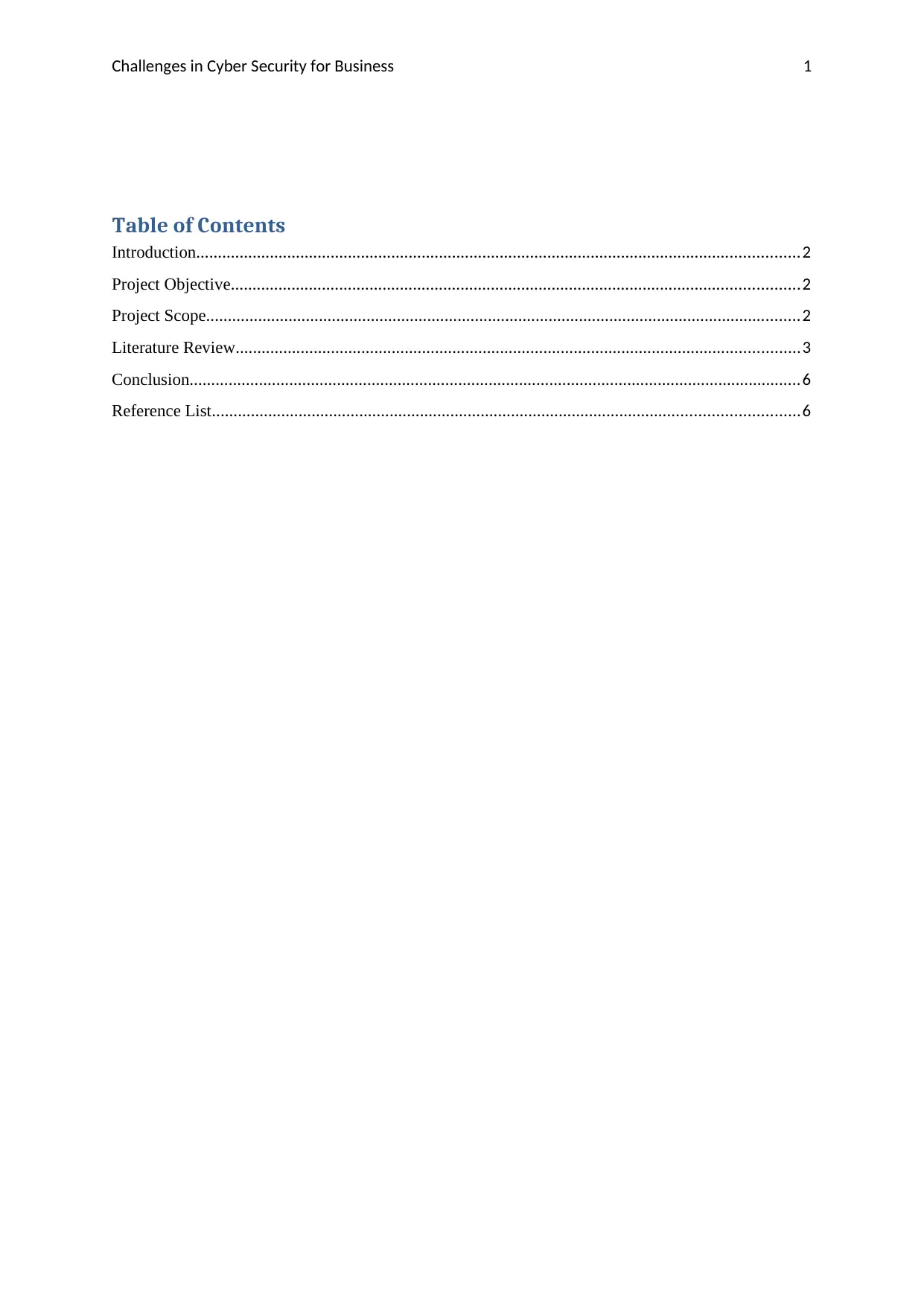
Challenges in Cyber Security for Business 1
Table of Contents
Introduction...........................................................................................................................................2
Project Objective...................................................................................................................................2
Project Scope.........................................................................................................................................2
Literature Review..................................................................................................................................3
Conclusion.............................................................................................................................................6
Reference List.......................................................................................................................................6
Table of Contents
Introduction...........................................................................................................................................2
Project Objective...................................................................................................................................2
Project Scope.........................................................................................................................................2
Literature Review..................................................................................................................................3
Conclusion.............................................................................................................................................6
Reference List.......................................................................................................................................6
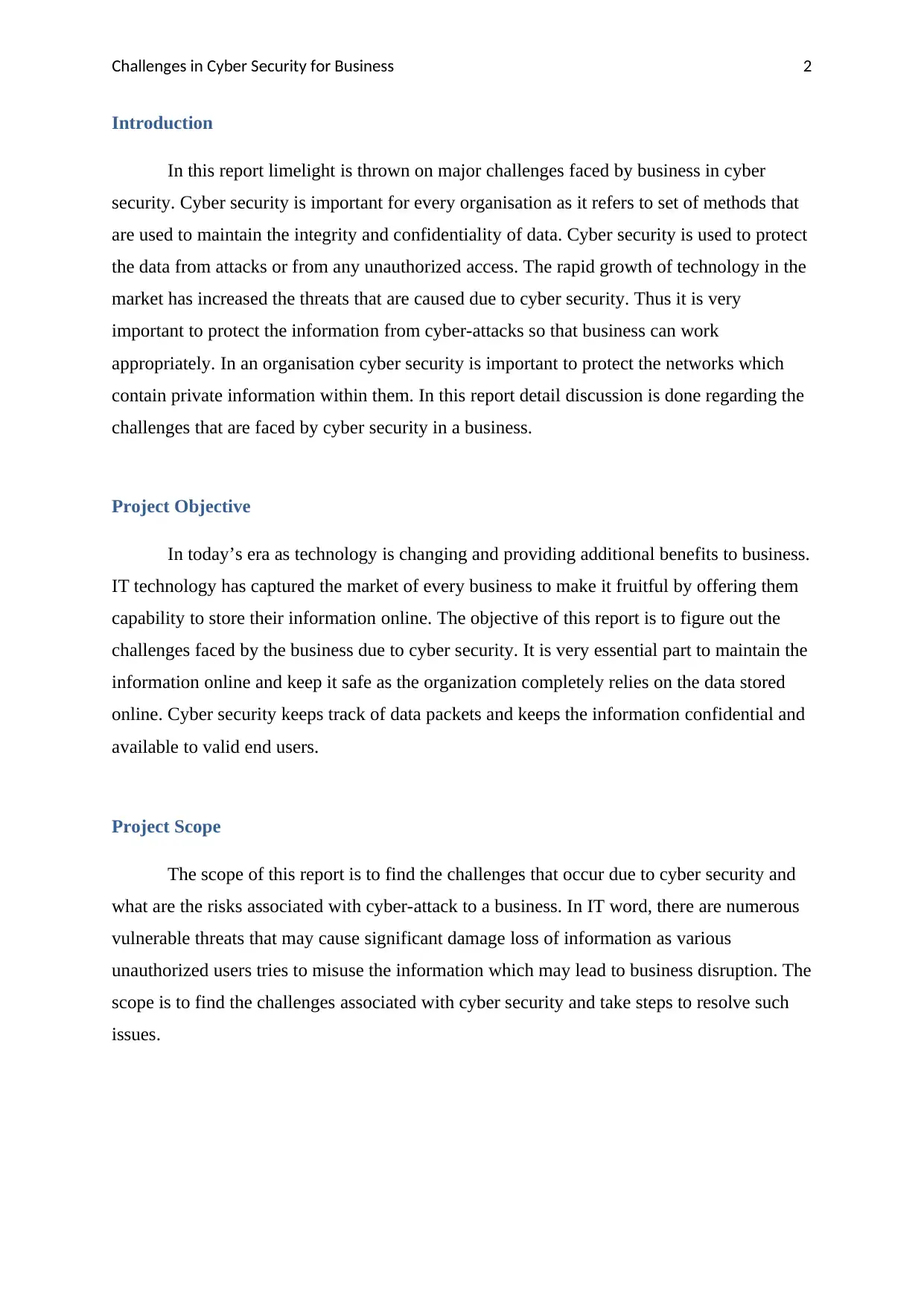
Challenges in Cyber Security for Business 2
Introduction
In this report limelight is thrown on major challenges faced by business in cyber
security. Cyber security is important for every organisation as it refers to set of methods that
are used to maintain the integrity and confidentiality of data. Cyber security is used to protect
the data from attacks or from any unauthorized access. The rapid growth of technology in the
market has increased the threats that are caused due to cyber security. Thus it is very
important to protect the information from cyber-attacks so that business can work
appropriately. In an organisation cyber security is important to protect the networks which
contain private information within them. In this report detail discussion is done regarding the
challenges that are faced by cyber security in a business.
Project Objective
In today’s era as technology is changing and providing additional benefits to business.
IT technology has captured the market of every business to make it fruitful by offering them
capability to store their information online. The objective of this report is to figure out the
challenges faced by the business due to cyber security. It is very essential part to maintain the
information online and keep it safe as the organization completely relies on the data stored
online. Cyber security keeps track of data packets and keeps the information confidential and
available to valid end users.
Project Scope
The scope of this report is to find the challenges that occur due to cyber security and
what are the risks associated with cyber-attack to a business. In IT word, there are numerous
vulnerable threats that may cause significant damage loss of information as various
unauthorized users tries to misuse the information which may lead to business disruption. The
scope is to find the challenges associated with cyber security and take steps to resolve such
issues.
Introduction
In this report limelight is thrown on major challenges faced by business in cyber
security. Cyber security is important for every organisation as it refers to set of methods that
are used to maintain the integrity and confidentiality of data. Cyber security is used to protect
the data from attacks or from any unauthorized access. The rapid growth of technology in the
market has increased the threats that are caused due to cyber security. Thus it is very
important to protect the information from cyber-attacks so that business can work
appropriately. In an organisation cyber security is important to protect the networks which
contain private information within them. In this report detail discussion is done regarding the
challenges that are faced by cyber security in a business.
Project Objective
In today’s era as technology is changing and providing additional benefits to business.
IT technology has captured the market of every business to make it fruitful by offering them
capability to store their information online. The objective of this report is to figure out the
challenges faced by the business due to cyber security. It is very essential part to maintain the
information online and keep it safe as the organization completely relies on the data stored
online. Cyber security keeps track of data packets and keeps the information confidential and
available to valid end users.
Project Scope
The scope of this report is to find the challenges that occur due to cyber security and
what are the risks associated with cyber-attack to a business. In IT word, there are numerous
vulnerable threats that may cause significant damage loss of information as various
unauthorized users tries to misuse the information which may lead to business disruption. The
scope is to find the challenges associated with cyber security and take steps to resolve such
issues.
⊘ This is a preview!⊘
Do you want full access?
Subscribe today to unlock all pages.

Trusted by 1+ million students worldwide
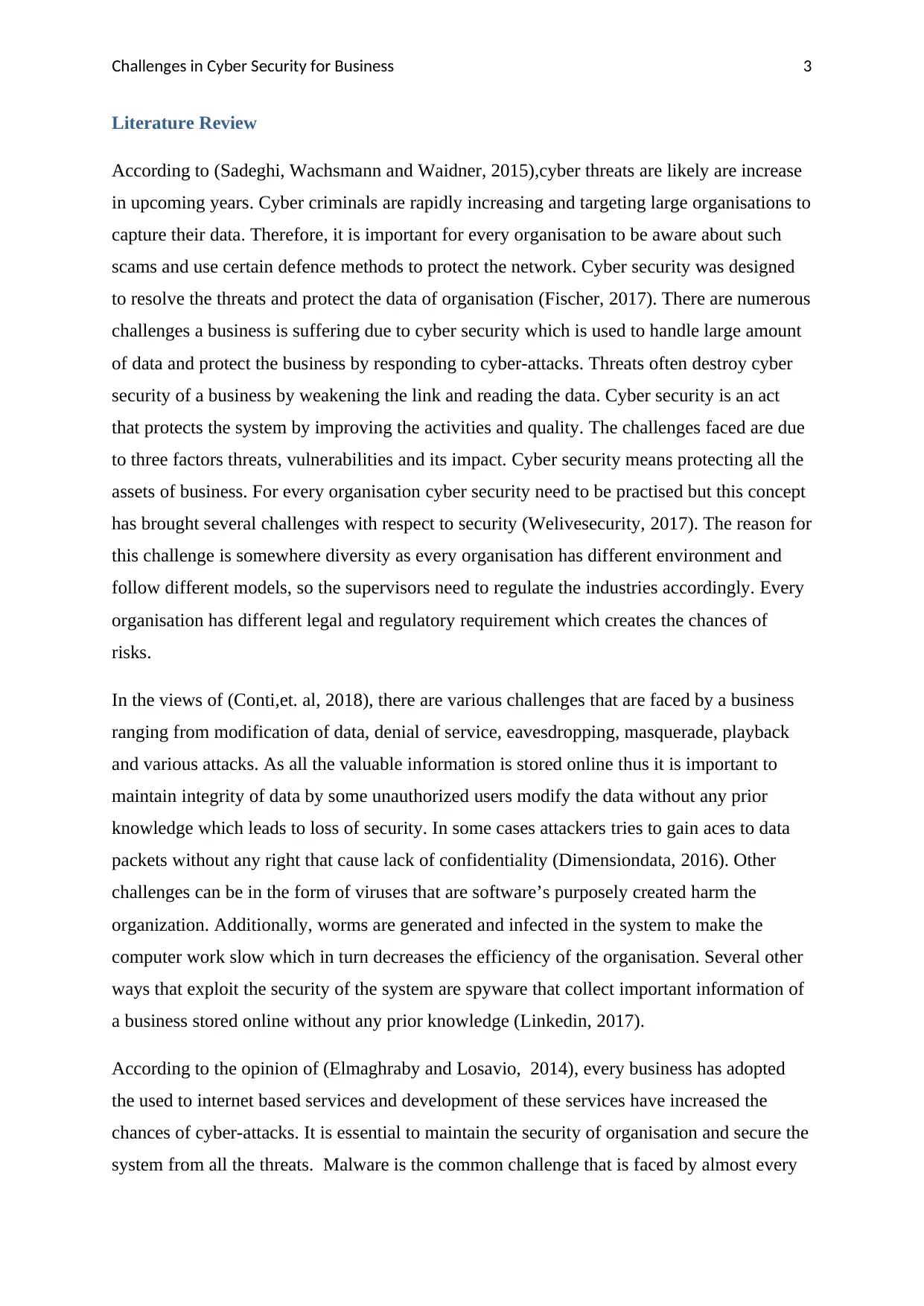
Challenges in Cyber Security for Business 3
Literature Review
According to (Sadeghi, Wachsmann and Waidner, 2015),cyber threats are likely are increase
in upcoming years. Cyber criminals are rapidly increasing and targeting large organisations to
capture their data. Therefore, it is important for every organisation to be aware about such
scams and use certain defence methods to protect the network. Cyber security was designed
to resolve the threats and protect the data of organisation (Fischer, 2017). There are numerous
challenges a business is suffering due to cyber security which is used to handle large amount
of data and protect the business by responding to cyber-attacks. Threats often destroy cyber
security of a business by weakening the link and reading the data. Cyber security is an act
that protects the system by improving the activities and quality. The challenges faced are due
to three factors threats, vulnerabilities and its impact. Cyber security means protecting all the
assets of business. For every organisation cyber security need to be practised but this concept
has brought several challenges with respect to security (Welivesecurity, 2017). The reason for
this challenge is somewhere diversity as every organisation has different environment and
follow different models, so the supervisors need to regulate the industries accordingly. Every
organisation has different legal and regulatory requirement which creates the chances of
risks.
In the views of (Conti,et. al, 2018), there are various challenges that are faced by a business
ranging from modification of data, denial of service, eavesdropping, masquerade, playback
and various attacks. As all the valuable information is stored online thus it is important to
maintain integrity of data by some unauthorized users modify the data without any prior
knowledge which leads to loss of security. In some cases attackers tries to gain aces to data
packets without any right that cause lack of confidentiality (Dimensiondata, 2016). Other
challenges can be in the form of viruses that are software’s purposely created harm the
organization. Additionally, worms are generated and infected in the system to make the
computer work slow which in turn decreases the efficiency of the organisation. Several other
ways that exploit the security of the system are spyware that collect important information of
a business stored online without any prior knowledge (Linkedin, 2017).
According to the opinion of (Elmaghraby and Losavio, 2014), every business has adopted
the used to internet based services and development of these services have increased the
chances of cyber-attacks. It is essential to maintain the security of organisation and secure the
system from all the threats. Malware is the common challenge that is faced by almost every
Literature Review
According to (Sadeghi, Wachsmann and Waidner, 2015),cyber threats are likely are increase
in upcoming years. Cyber criminals are rapidly increasing and targeting large organisations to
capture their data. Therefore, it is important for every organisation to be aware about such
scams and use certain defence methods to protect the network. Cyber security was designed
to resolve the threats and protect the data of organisation (Fischer, 2017). There are numerous
challenges a business is suffering due to cyber security which is used to handle large amount
of data and protect the business by responding to cyber-attacks. Threats often destroy cyber
security of a business by weakening the link and reading the data. Cyber security is an act
that protects the system by improving the activities and quality. The challenges faced are due
to three factors threats, vulnerabilities and its impact. Cyber security means protecting all the
assets of business. For every organisation cyber security need to be practised but this concept
has brought several challenges with respect to security (Welivesecurity, 2017). The reason for
this challenge is somewhere diversity as every organisation has different environment and
follow different models, so the supervisors need to regulate the industries accordingly. Every
organisation has different legal and regulatory requirement which creates the chances of
risks.
In the views of (Conti,et. al, 2018), there are various challenges that are faced by a business
ranging from modification of data, denial of service, eavesdropping, masquerade, playback
and various attacks. As all the valuable information is stored online thus it is important to
maintain integrity of data by some unauthorized users modify the data without any prior
knowledge which leads to loss of security. In some cases attackers tries to gain aces to data
packets without any right that cause lack of confidentiality (Dimensiondata, 2016). Other
challenges can be in the form of viruses that are software’s purposely created harm the
organization. Additionally, worms are generated and infected in the system to make the
computer work slow which in turn decreases the efficiency of the organisation. Several other
ways that exploit the security of the system are spyware that collect important information of
a business stored online without any prior knowledge (Linkedin, 2017).
According to the opinion of (Elmaghraby and Losavio, 2014), every business has adopted
the used to internet based services and development of these services have increased the
chances of cyber-attacks. It is essential to maintain the security of organisation and secure the
system from all the threats. Malware is the common challenge that is faced by almost every
Paraphrase This Document
Need a fresh take? Get an instant paraphrase of this document with our AI Paraphraser
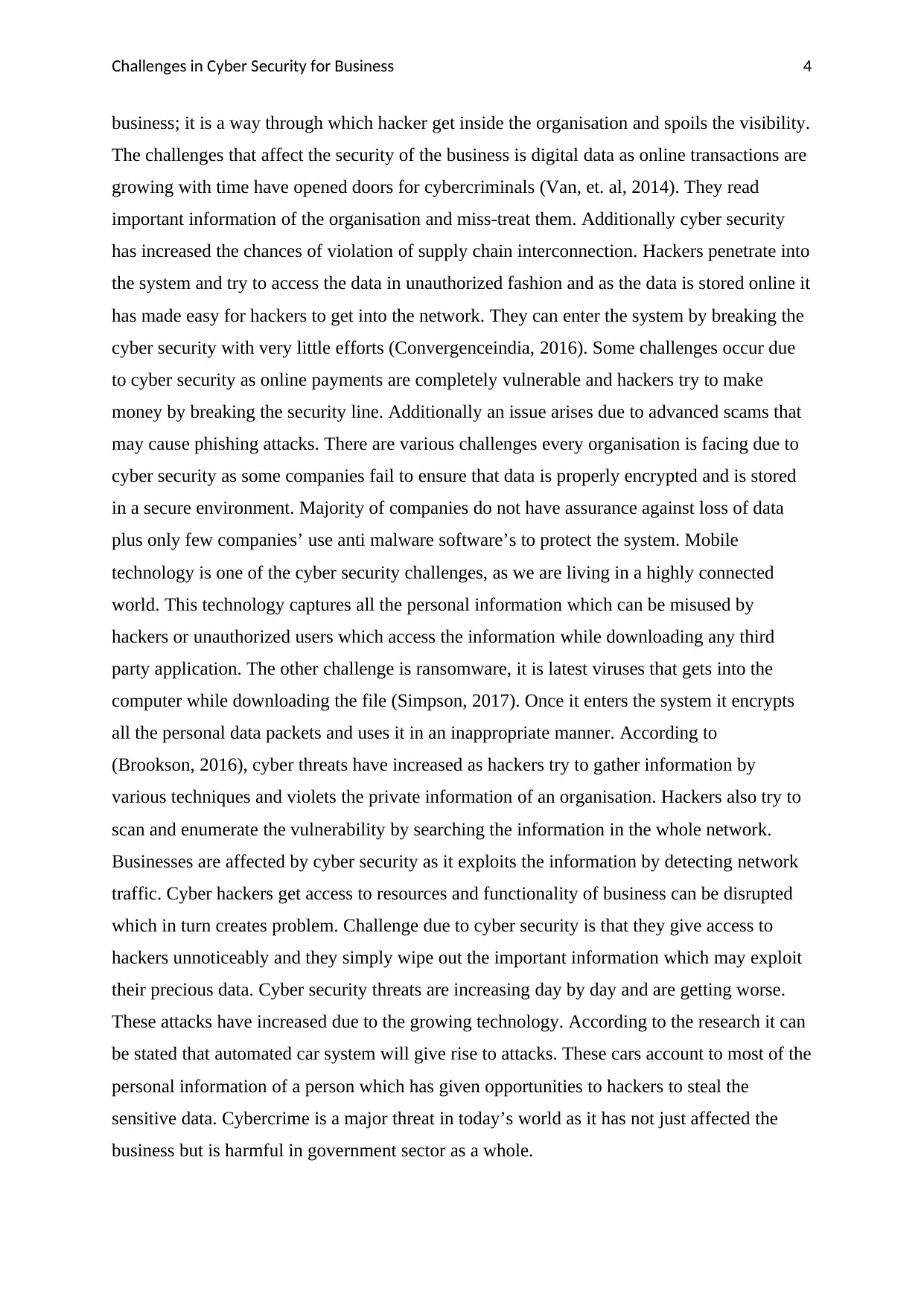
Challenges in Cyber Security for Business 4
business; it is a way through which hacker get inside the organisation and spoils the visibility.
The challenges that affect the security of the business is digital data as online transactions are
growing with time have opened doors for cybercriminals (Van, et. al, 2014). They read
important information of the organisation and miss-treat them. Additionally cyber security
has increased the chances of violation of supply chain interconnection. Hackers penetrate into
the system and try to access the data in unauthorized fashion and as the data is stored online it
has made easy for hackers to get into the network. They can enter the system by breaking the
cyber security with very little efforts (Convergenceindia, 2016). Some challenges occur due
to cyber security as online payments are completely vulnerable and hackers try to make
money by breaking the security line. Additionally an issue arises due to advanced scams that
may cause phishing attacks. There are various challenges every organisation is facing due to
cyber security as some companies fail to ensure that data is properly encrypted and is stored
in a secure environment. Majority of companies do not have assurance against loss of data
plus only few companies’ use anti malware software’s to protect the system. Mobile
technology is one of the cyber security challenges, as we are living in a highly connected
world. This technology captures all the personal information which can be misused by
hackers or unauthorized users which access the information while downloading any third
party application. The other challenge is ransomware, it is latest viruses that gets into the
computer while downloading the file (Simpson, 2017). Once it enters the system it encrypts
all the personal data packets and uses it in an inappropriate manner. According to
(Brookson, 2016), cyber threats have increased as hackers try to gather information by
various techniques and violets the private information of an organisation. Hackers also try to
scan and enumerate the vulnerability by searching the information in the whole network.
Businesses are affected by cyber security as it exploits the information by detecting network
traffic. Cyber hackers get access to resources and functionality of business can be disrupted
which in turn creates problem. Challenge due to cyber security is that they give access to
hackers unnoticeably and they simply wipe out the important information which may exploit
their precious data. Cyber security threats are increasing day by day and are getting worse.
These attacks have increased due to the growing technology. According to the research it can
be stated that automated car system will give rise to attacks. These cars account to most of the
personal information of a person which has given opportunities to hackers to steal the
sensitive data. Cybercrime is a major threat in today’s world as it has not just affected the
business but is harmful in government sector as a whole.
business; it is a way through which hacker get inside the organisation and spoils the visibility.
The challenges that affect the security of the business is digital data as online transactions are
growing with time have opened doors for cybercriminals (Van, et. al, 2014). They read
important information of the organisation and miss-treat them. Additionally cyber security
has increased the chances of violation of supply chain interconnection. Hackers penetrate into
the system and try to access the data in unauthorized fashion and as the data is stored online it
has made easy for hackers to get into the network. They can enter the system by breaking the
cyber security with very little efforts (Convergenceindia, 2016). Some challenges occur due
to cyber security as online payments are completely vulnerable and hackers try to make
money by breaking the security line. Additionally an issue arises due to advanced scams that
may cause phishing attacks. There are various challenges every organisation is facing due to
cyber security as some companies fail to ensure that data is properly encrypted and is stored
in a secure environment. Majority of companies do not have assurance against loss of data
plus only few companies’ use anti malware software’s to protect the system. Mobile
technology is one of the cyber security challenges, as we are living in a highly connected
world. This technology captures all the personal information which can be misused by
hackers or unauthorized users which access the information while downloading any third
party application. The other challenge is ransomware, it is latest viruses that gets into the
computer while downloading the file (Simpson, 2017). Once it enters the system it encrypts
all the personal data packets and uses it in an inappropriate manner. According to
(Brookson, 2016), cyber threats have increased as hackers try to gather information by
various techniques and violets the private information of an organisation. Hackers also try to
scan and enumerate the vulnerability by searching the information in the whole network.
Businesses are affected by cyber security as it exploits the information by detecting network
traffic. Cyber hackers get access to resources and functionality of business can be disrupted
which in turn creates problem. Challenge due to cyber security is that they give access to
hackers unnoticeably and they simply wipe out the important information which may exploit
their precious data. Cyber security threats are increasing day by day and are getting worse.
These attacks have increased due to the growing technology. According to the research it can
be stated that automated car system will give rise to attacks. These cars account to most of the
personal information of a person which has given opportunities to hackers to steal the
sensitive data. Cybercrime is a major threat in today’s world as it has not just affected the
business but is harmful in government sector as a whole.
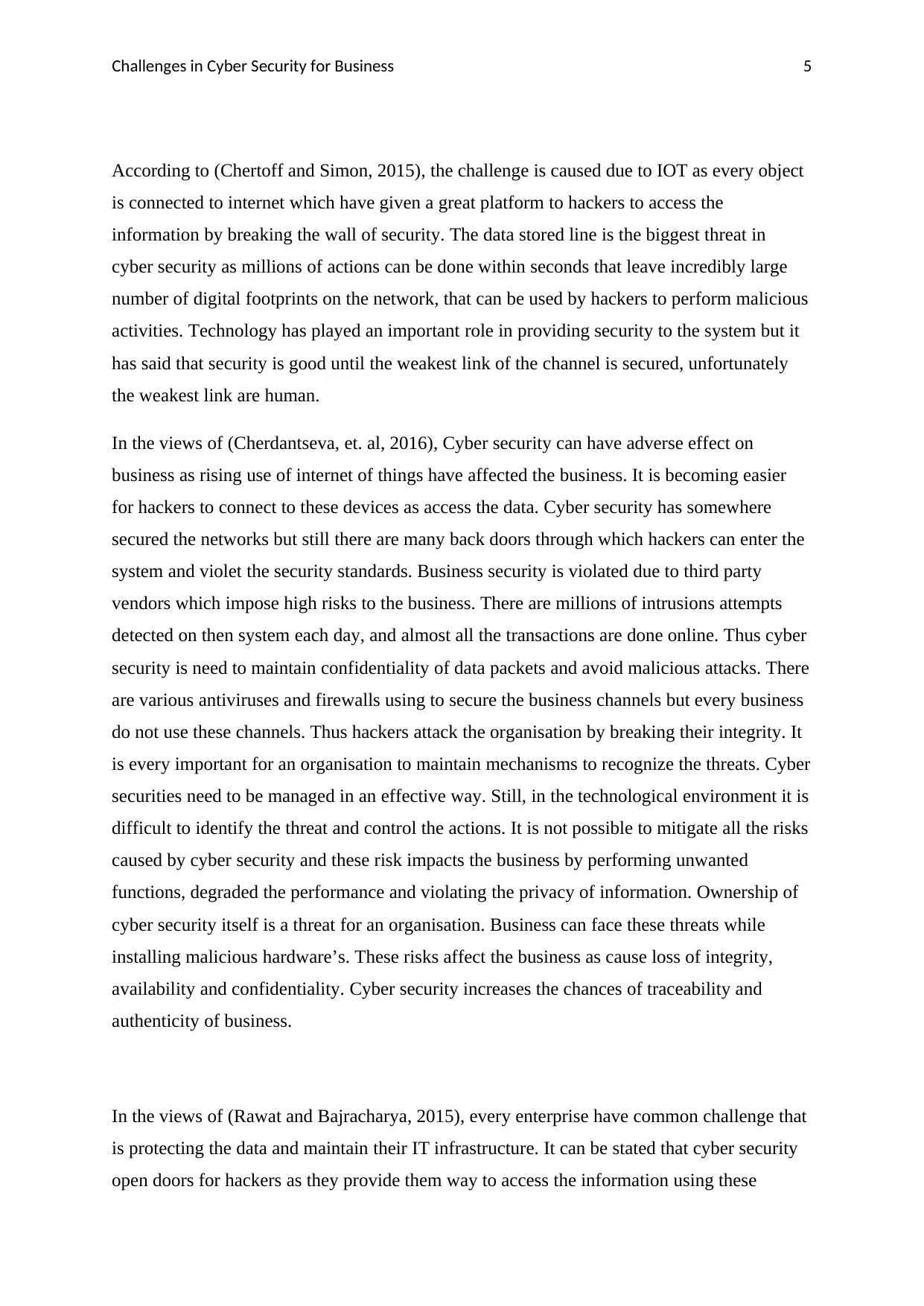
Challenges in Cyber Security for Business 5
According to (Chertoff and Simon, 2015), the challenge is caused due to IOT as every object
is connected to internet which have given a great platform to hackers to access the
information by breaking the wall of security. The data stored line is the biggest threat in
cyber security as millions of actions can be done within seconds that leave incredibly large
number of digital footprints on the network, that can be used by hackers to perform malicious
activities. Technology has played an important role in providing security to the system but it
has said that security is good until the weakest link of the channel is secured, unfortunately
the weakest link are human.
In the views of (Cherdantseva, et. al, 2016), Cyber security can have adverse effect on
business as rising use of internet of things have affected the business. It is becoming easier
for hackers to connect to these devices as access the data. Cyber security has somewhere
secured the networks but still there are many back doors through which hackers can enter the
system and violet the security standards. Business security is violated due to third party
vendors which impose high risks to the business. There are millions of intrusions attempts
detected on then system each day, and almost all the transactions are done online. Thus cyber
security is need to maintain confidentiality of data packets and avoid malicious attacks. There
are various antiviruses and firewalls using to secure the business channels but every business
do not use these channels. Thus hackers attack the organisation by breaking their integrity. It
is every important for an organisation to maintain mechanisms to recognize the threats. Cyber
securities need to be managed in an effective way. Still, in the technological environment it is
difficult to identify the threat and control the actions. It is not possible to mitigate all the risks
caused by cyber security and these risk impacts the business by performing unwanted
functions, degraded the performance and violating the privacy of information. Ownership of
cyber security itself is a threat for an organisation. Business can face these threats while
installing malicious hardware’s. These risks affect the business as cause loss of integrity,
availability and confidentiality. Cyber security increases the chances of traceability and
authenticity of business.
In the views of (Rawat and Bajracharya, 2015), every enterprise have common challenge that
is protecting the data and maintain their IT infrastructure. It can be stated that cyber security
open doors for hackers as they provide them way to access the information using these
According to (Chertoff and Simon, 2015), the challenge is caused due to IOT as every object
is connected to internet which have given a great platform to hackers to access the
information by breaking the wall of security. The data stored line is the biggest threat in
cyber security as millions of actions can be done within seconds that leave incredibly large
number of digital footprints on the network, that can be used by hackers to perform malicious
activities. Technology has played an important role in providing security to the system but it
has said that security is good until the weakest link of the channel is secured, unfortunately
the weakest link are human.
In the views of (Cherdantseva, et. al, 2016), Cyber security can have adverse effect on
business as rising use of internet of things have affected the business. It is becoming easier
for hackers to connect to these devices as access the data. Cyber security has somewhere
secured the networks but still there are many back doors through which hackers can enter the
system and violet the security standards. Business security is violated due to third party
vendors which impose high risks to the business. There are millions of intrusions attempts
detected on then system each day, and almost all the transactions are done online. Thus cyber
security is need to maintain confidentiality of data packets and avoid malicious attacks. There
are various antiviruses and firewalls using to secure the business channels but every business
do not use these channels. Thus hackers attack the organisation by breaking their integrity. It
is every important for an organisation to maintain mechanisms to recognize the threats. Cyber
securities need to be managed in an effective way. Still, in the technological environment it is
difficult to identify the threat and control the actions. It is not possible to mitigate all the risks
caused by cyber security and these risk impacts the business by performing unwanted
functions, degraded the performance and violating the privacy of information. Ownership of
cyber security itself is a threat for an organisation. Business can face these threats while
installing malicious hardware’s. These risks affect the business as cause loss of integrity,
availability and confidentiality. Cyber security increases the chances of traceability and
authenticity of business.
In the views of (Rawat and Bajracharya, 2015), every enterprise have common challenge that
is protecting the data and maintain their IT infrastructure. It can be stated that cyber security
open doors for hackers as they provide them way to access the information using these
⊘ This is a preview!⊘
Do you want full access?
Subscribe today to unlock all pages.

Trusted by 1+ million students worldwide
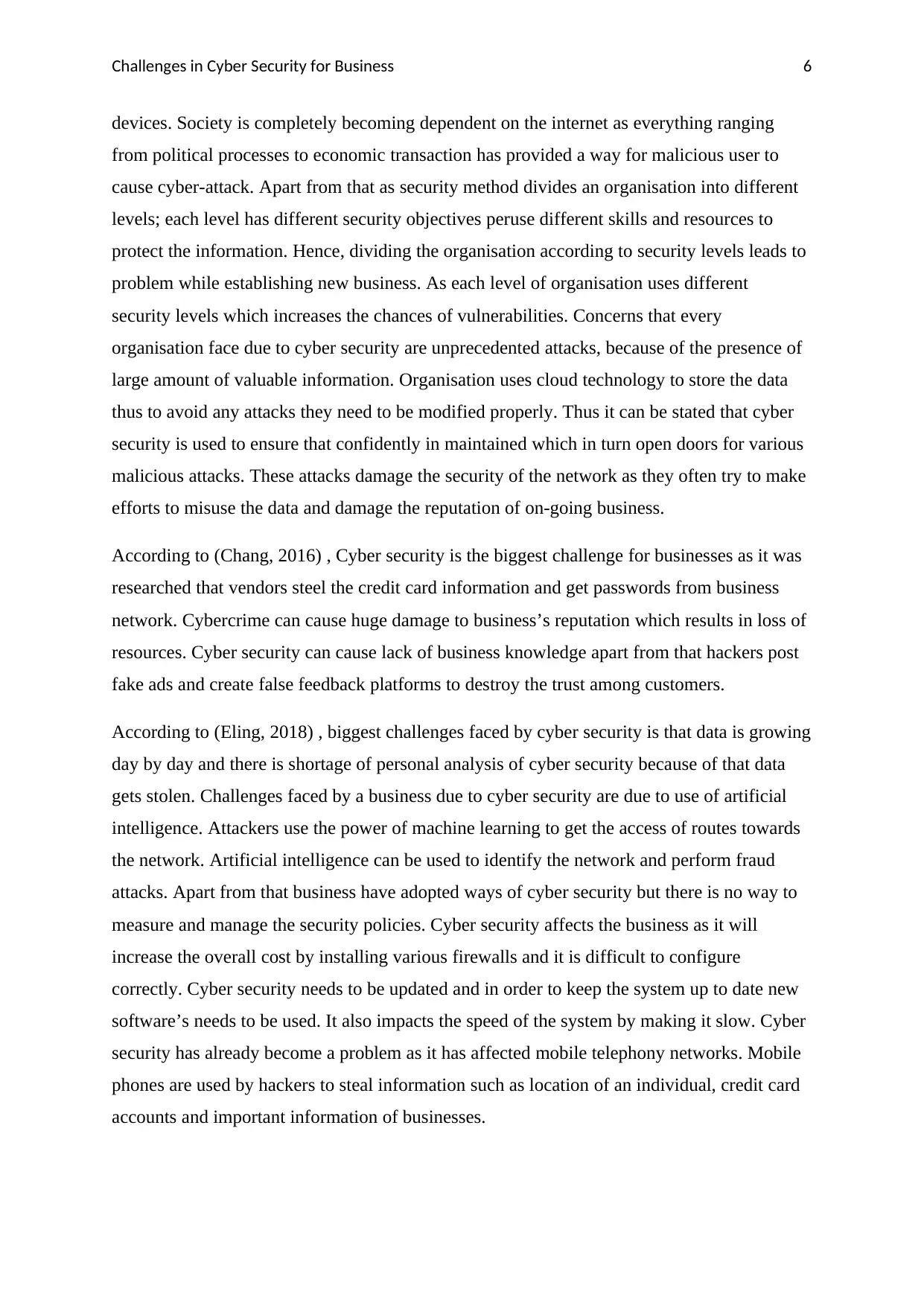
Challenges in Cyber Security for Business 6
devices. Society is completely becoming dependent on the internet as everything ranging
from political processes to economic transaction has provided a way for malicious user to
cause cyber-attack. Apart from that as security method divides an organisation into different
levels; each level has different security objectives peruse different skills and resources to
protect the information. Hence, dividing the organisation according to security levels leads to
problem while establishing new business. As each level of organisation uses different
security levels which increases the chances of vulnerabilities. Concerns that every
organisation face due to cyber security are unprecedented attacks, because of the presence of
large amount of valuable information. Organisation uses cloud technology to store the data
thus to avoid any attacks they need to be modified properly. Thus it can be stated that cyber
security is used to ensure that confidently in maintained which in turn open doors for various
malicious attacks. These attacks damage the security of the network as they often try to make
efforts to misuse the data and damage the reputation of on-going business.
According to (Chang, 2016) , Cyber security is the biggest challenge for businesses as it was
researched that vendors steel the credit card information and get passwords from business
network. Cybercrime can cause huge damage to business’s reputation which results in loss of
resources. Cyber security can cause lack of business knowledge apart from that hackers post
fake ads and create false feedback platforms to destroy the trust among customers.
According to (Eling, 2018) , biggest challenges faced by cyber security is that data is growing
day by day and there is shortage of personal analysis of cyber security because of that data
gets stolen. Challenges faced by a business due to cyber security are due to use of artificial
intelligence. Attackers use the power of machine learning to get the access of routes towards
the network. Artificial intelligence can be used to identify the network and perform fraud
attacks. Apart from that business have adopted ways of cyber security but there is no way to
measure and manage the security policies. Cyber security affects the business as it will
increase the overall cost by installing various firewalls and it is difficult to configure
correctly. Cyber security needs to be updated and in order to keep the system up to date new
software’s needs to be used. It also impacts the speed of the system by making it slow. Cyber
security has already become a problem as it has affected mobile telephony networks. Mobile
phones are used by hackers to steal information such as location of an individual, credit card
accounts and important information of businesses.
devices. Society is completely becoming dependent on the internet as everything ranging
from political processes to economic transaction has provided a way for malicious user to
cause cyber-attack. Apart from that as security method divides an organisation into different
levels; each level has different security objectives peruse different skills and resources to
protect the information. Hence, dividing the organisation according to security levels leads to
problem while establishing new business. As each level of organisation uses different
security levels which increases the chances of vulnerabilities. Concerns that every
organisation face due to cyber security are unprecedented attacks, because of the presence of
large amount of valuable information. Organisation uses cloud technology to store the data
thus to avoid any attacks they need to be modified properly. Thus it can be stated that cyber
security is used to ensure that confidently in maintained which in turn open doors for various
malicious attacks. These attacks damage the security of the network as they often try to make
efforts to misuse the data and damage the reputation of on-going business.
According to (Chang, 2016) , Cyber security is the biggest challenge for businesses as it was
researched that vendors steel the credit card information and get passwords from business
network. Cybercrime can cause huge damage to business’s reputation which results in loss of
resources. Cyber security can cause lack of business knowledge apart from that hackers post
fake ads and create false feedback platforms to destroy the trust among customers.
According to (Eling, 2018) , biggest challenges faced by cyber security is that data is growing
day by day and there is shortage of personal analysis of cyber security because of that data
gets stolen. Challenges faced by a business due to cyber security are due to use of artificial
intelligence. Attackers use the power of machine learning to get the access of routes towards
the network. Artificial intelligence can be used to identify the network and perform fraud
attacks. Apart from that business have adopted ways of cyber security but there is no way to
measure and manage the security policies. Cyber security affects the business as it will
increase the overall cost by installing various firewalls and it is difficult to configure
correctly. Cyber security needs to be updated and in order to keep the system up to date new
software’s needs to be used. It also impacts the speed of the system by making it slow. Cyber
security has already become a problem as it has affected mobile telephony networks. Mobile
phones are used by hackers to steal information such as location of an individual, credit card
accounts and important information of businesses.
Paraphrase This Document
Need a fresh take? Get an instant paraphrase of this document with our AI Paraphraser
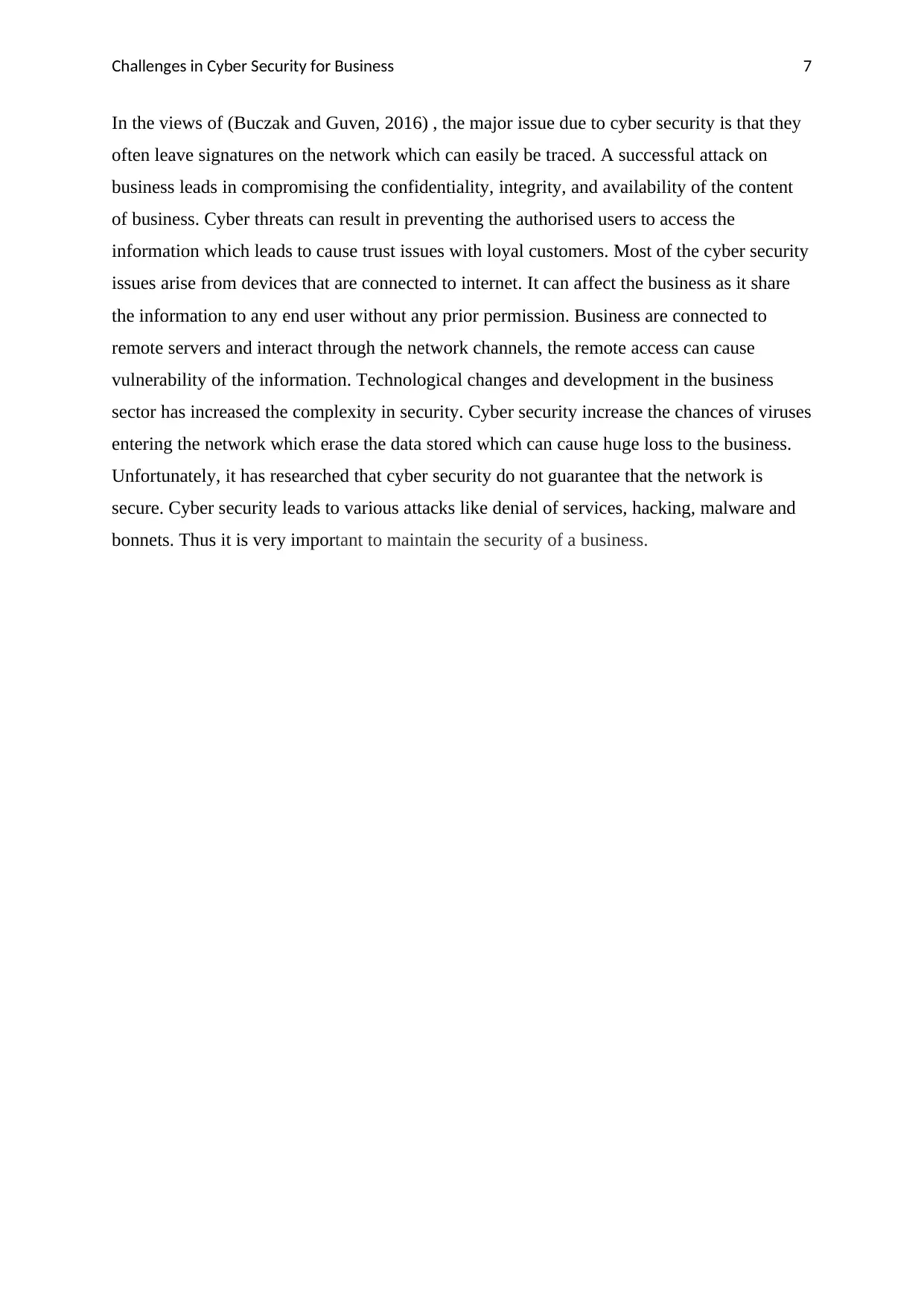
Challenges in Cyber Security for Business 7
In the views of (Buczak and Guven, 2016) , the major issue due to cyber security is that they
often leave signatures on the network which can easily be traced. A successful attack on
business leads in compromising the confidentiality, integrity, and availability of the content
of business. Cyber threats can result in preventing the authorised users to access the
information which leads to cause trust issues with loyal customers. Most of the cyber security
issues arise from devices that are connected to internet. It can affect the business as it share
the information to any end user without any prior permission. Business are connected to
remote servers and interact through the network channels, the remote access can cause
vulnerability of the information. Technological changes and development in the business
sector has increased the complexity in security. Cyber security increase the chances of viruses
entering the network which erase the data stored which can cause huge loss to the business.
Unfortunately, it has researched that cyber security do not guarantee that the network is
secure. Cyber security leads to various attacks like denial of services, hacking, malware and
bonnets. Thus it is very important to maintain the security of a business.
In the views of (Buczak and Guven, 2016) , the major issue due to cyber security is that they
often leave signatures on the network which can easily be traced. A successful attack on
business leads in compromising the confidentiality, integrity, and availability of the content
of business. Cyber threats can result in preventing the authorised users to access the
information which leads to cause trust issues with loyal customers. Most of the cyber security
issues arise from devices that are connected to internet. It can affect the business as it share
the information to any end user without any prior permission. Business are connected to
remote servers and interact through the network channels, the remote access can cause
vulnerability of the information. Technological changes and development in the business
sector has increased the complexity in security. Cyber security increase the chances of viruses
entering the network which erase the data stored which can cause huge loss to the business.
Unfortunately, it has researched that cyber security do not guarantee that the network is
secure. Cyber security leads to various attacks like denial of services, hacking, malware and
bonnets. Thus it is very important to maintain the security of a business.

Challenges in Cyber Security for Business 8
Conclusion
It can be concluded from the report that information technology has altered the
methods for business as it provide the business to use automated and updated technology to
enhance the growth of the company. Cyber security has allowed the firms to increase their
efficiency and effectiveness by storing their information online. As the information is
accessible from anywhere and at any time, it has increased the chances of cyber-attacks. In
this the discussion is done upon various challenges that businesses are facing due to cyber –
security.
Conclusion
It can be concluded from the report that information technology has altered the
methods for business as it provide the business to use automated and updated technology to
enhance the growth of the company. Cyber security has allowed the firms to increase their
efficiency and effectiveness by storing their information online. As the information is
accessible from anywhere and at any time, it has increased the chances of cyber-attacks. In
this the discussion is done upon various challenges that businesses are facing due to cyber –
security.
⊘ This is a preview!⊘
Do you want full access?
Subscribe today to unlock all pages.

Trusted by 1+ million students worldwide
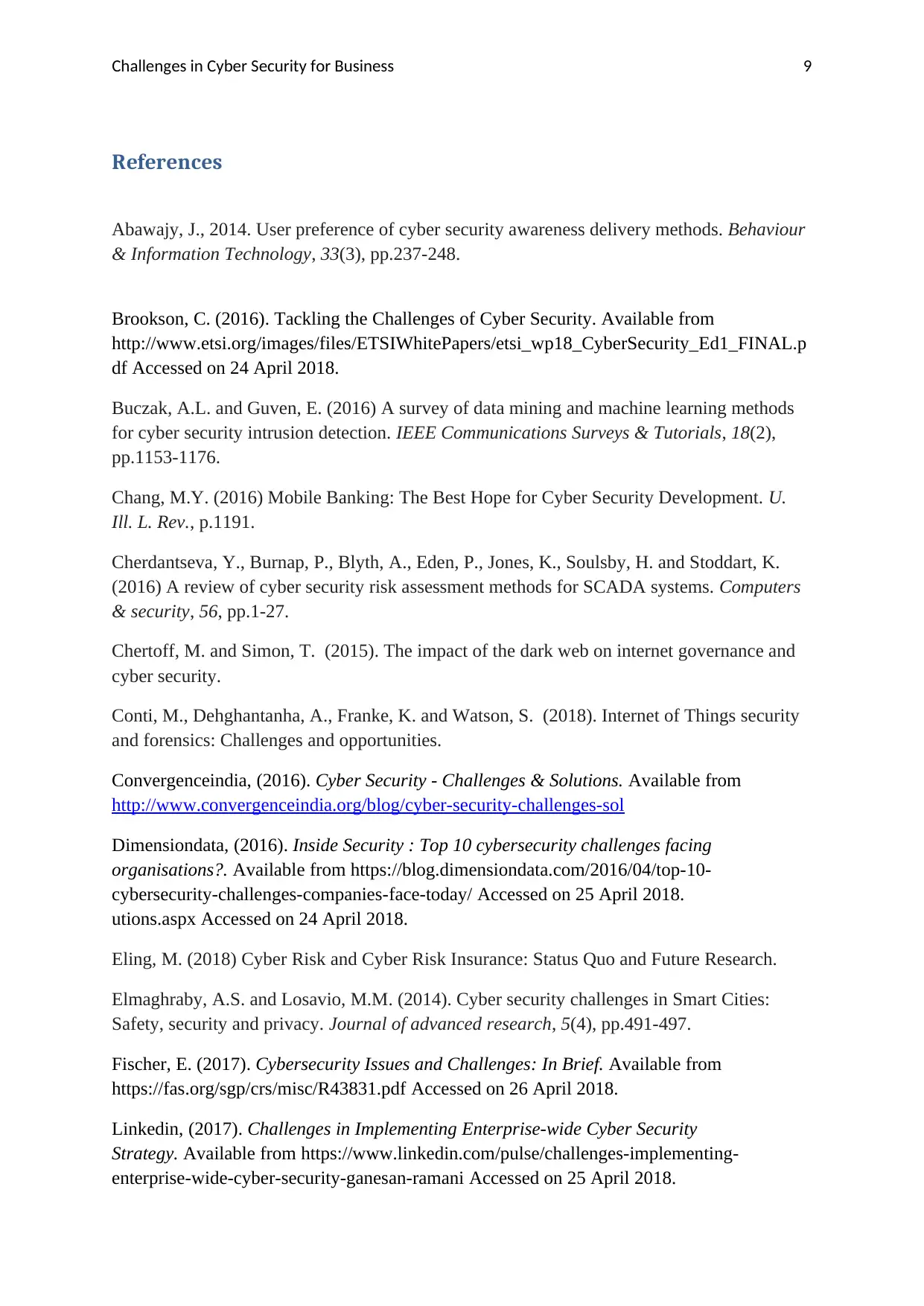
Challenges in Cyber Security for Business 9
References
Abawajy, J., 2014. User preference of cyber security awareness delivery methods. Behaviour
& Information Technology, 33(3), pp.237-248.
Brookson, C. (2016). Tackling the Challenges of Cyber Security. Available from
http://www.etsi.org/images/files/ETSIWhitePapers/etsi_wp18_CyberSecurity_Ed1_FINAL.p
df Accessed on 24 April 2018.
Buczak, A.L. and Guven, E. (2016) A survey of data mining and machine learning methods
for cyber security intrusion detection. IEEE Communications Surveys & Tutorials, 18(2),
pp.1153-1176.
Chang, M.Y. (2016) Mobile Banking: The Best Hope for Cyber Security Development. U.
Ill. L. Rev., p.1191.
Cherdantseva, Y., Burnap, P., Blyth, A., Eden, P., Jones, K., Soulsby, H. and Stoddart, K.
(2016) A review of cyber security risk assessment methods for SCADA systems. Computers
& security, 56, pp.1-27.
Chertoff, M. and Simon, T. (2015). The impact of the dark web on internet governance and
cyber security.
Conti, M., Dehghantanha, A., Franke, K. and Watson, S. (2018). Internet of Things security
and forensics: Challenges and opportunities.
Convergenceindia, (2016). Cyber Security - Challenges & Solutions. Available from
http://www.convergenceindia.org/blog/cyber-security-challenges-sol
Dimensiondata, (2016). Inside Security : Top 10 cybersecurity challenges facing
organisations?. Available from https://blog.dimensiondata.com/2016/04/top-10-
cybersecurity-challenges-companies-face-today/ Accessed on 25 April 2018.
utions.aspx Accessed on 24 April 2018.
Eling, M. (2018) Cyber Risk and Cyber Risk Insurance: Status Quo and Future Research.
Elmaghraby, A.S. and Losavio, M.M. (2014). Cyber security challenges in Smart Cities:
Safety, security and privacy. Journal of advanced research, 5(4), pp.491-497.
Fischer, E. (2017). Cybersecurity Issues and Challenges: In Brief. Available from
https://fas.org/sgp/crs/misc/R43831.pdf Accessed on 26 April 2018.
Linkedin, (2017). Challenges in Implementing Enterprise-wide Cyber Security
Strategy. Available from https://www.linkedin.com/pulse/challenges-implementing-
enterprise-wide-cyber-security-ganesan-ramani Accessed on 25 April 2018.
References
Abawajy, J., 2014. User preference of cyber security awareness delivery methods. Behaviour
& Information Technology, 33(3), pp.237-248.
Brookson, C. (2016). Tackling the Challenges of Cyber Security. Available from
http://www.etsi.org/images/files/ETSIWhitePapers/etsi_wp18_CyberSecurity_Ed1_FINAL.p
df Accessed on 24 April 2018.
Buczak, A.L. and Guven, E. (2016) A survey of data mining and machine learning methods
for cyber security intrusion detection. IEEE Communications Surveys & Tutorials, 18(2),
pp.1153-1176.
Chang, M.Y. (2016) Mobile Banking: The Best Hope for Cyber Security Development. U.
Ill. L. Rev., p.1191.
Cherdantseva, Y., Burnap, P., Blyth, A., Eden, P., Jones, K., Soulsby, H. and Stoddart, K.
(2016) A review of cyber security risk assessment methods for SCADA systems. Computers
& security, 56, pp.1-27.
Chertoff, M. and Simon, T. (2015). The impact of the dark web on internet governance and
cyber security.
Conti, M., Dehghantanha, A., Franke, K. and Watson, S. (2018). Internet of Things security
and forensics: Challenges and opportunities.
Convergenceindia, (2016). Cyber Security - Challenges & Solutions. Available from
http://www.convergenceindia.org/blog/cyber-security-challenges-sol
Dimensiondata, (2016). Inside Security : Top 10 cybersecurity challenges facing
organisations?. Available from https://blog.dimensiondata.com/2016/04/top-10-
cybersecurity-challenges-companies-face-today/ Accessed on 25 April 2018.
utions.aspx Accessed on 24 April 2018.
Eling, M. (2018) Cyber Risk and Cyber Risk Insurance: Status Quo and Future Research.
Elmaghraby, A.S. and Losavio, M.M. (2014). Cyber security challenges in Smart Cities:
Safety, security and privacy. Journal of advanced research, 5(4), pp.491-497.
Fischer, E. (2017). Cybersecurity Issues and Challenges: In Brief. Available from
https://fas.org/sgp/crs/misc/R43831.pdf Accessed on 26 April 2018.
Linkedin, (2017). Challenges in Implementing Enterprise-wide Cyber Security
Strategy. Available from https://www.linkedin.com/pulse/challenges-implementing-
enterprise-wide-cyber-security-ganesan-ramani Accessed on 25 April 2018.
Paraphrase This Document
Need a fresh take? Get an instant paraphrase of this document with our AI Paraphraser
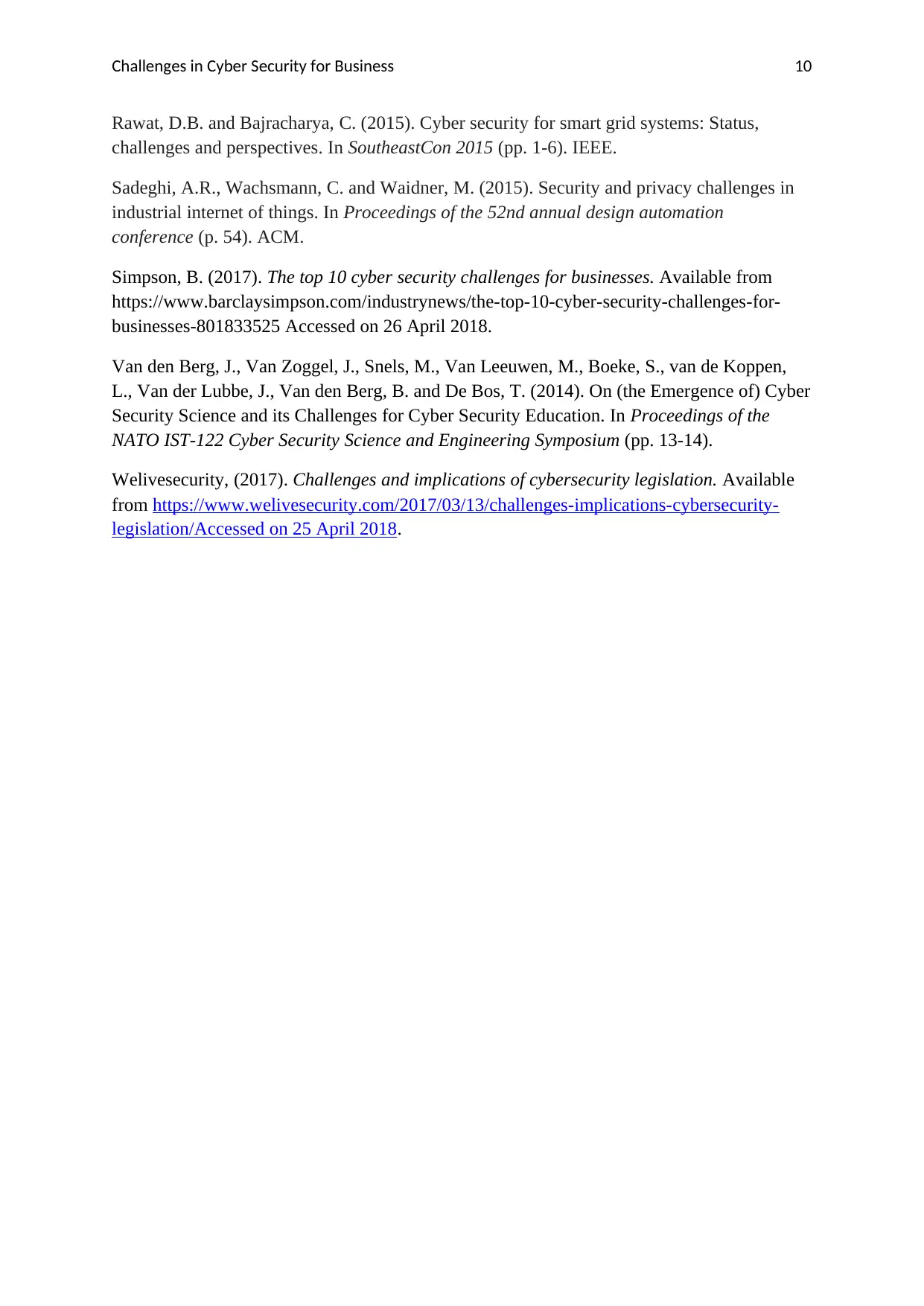
Challenges in Cyber Security for Business 10
Rawat, D.B. and Bajracharya, C. (2015). Cyber security for smart grid systems: Status,
challenges and perspectives. In SoutheastCon 2015 (pp. 1-6). IEEE.
Sadeghi, A.R., Wachsmann, C. and Waidner, M. (2015). Security and privacy challenges in
industrial internet of things. In Proceedings of the 52nd annual design automation
conference (p. 54). ACM.
Simpson, B. (2017). The top 10 cyber security challenges for businesses. Available from
https://www.barclaysimpson.com/industrynews/the-top-10-cyber-security-challenges-for-
businesses-801833525 Accessed on 26 April 2018.
Van den Berg, J., Van Zoggel, J., Snels, M., Van Leeuwen, M., Boeke, S., van de Koppen,
L., Van der Lubbe, J., Van den Berg, B. and De Bos, T. (2014). On (the Emergence of) Cyber
Security Science and its Challenges for Cyber Security Education. In Proceedings of the
NATO IST-122 Cyber Security Science and Engineering Symposium (pp. 13-14).
Welivesecurity, (2017). Challenges and implications of cybersecurity legislation. Available
from https://www.welivesecurity.com/2017/03/13/challenges-implications-cybersecurity-
legislation/Accessed on 25 April 2018.
Rawat, D.B. and Bajracharya, C. (2015). Cyber security for smart grid systems: Status,
challenges and perspectives. In SoutheastCon 2015 (pp. 1-6). IEEE.
Sadeghi, A.R., Wachsmann, C. and Waidner, M. (2015). Security and privacy challenges in
industrial internet of things. In Proceedings of the 52nd annual design automation
conference (p. 54). ACM.
Simpson, B. (2017). The top 10 cyber security challenges for businesses. Available from
https://www.barclaysimpson.com/industrynews/the-top-10-cyber-security-challenges-for-
businesses-801833525 Accessed on 26 April 2018.
Van den Berg, J., Van Zoggel, J., Snels, M., Van Leeuwen, M., Boeke, S., van de Koppen,
L., Van der Lubbe, J., Van den Berg, B. and De Bos, T. (2014). On (the Emergence of) Cyber
Security Science and its Challenges for Cyber Security Education. In Proceedings of the
NATO IST-122 Cyber Security Science and Engineering Symposium (pp. 13-14).
Welivesecurity, (2017). Challenges and implications of cybersecurity legislation. Available
from https://www.welivesecurity.com/2017/03/13/challenges-implications-cybersecurity-
legislation/Accessed on 25 April 2018.
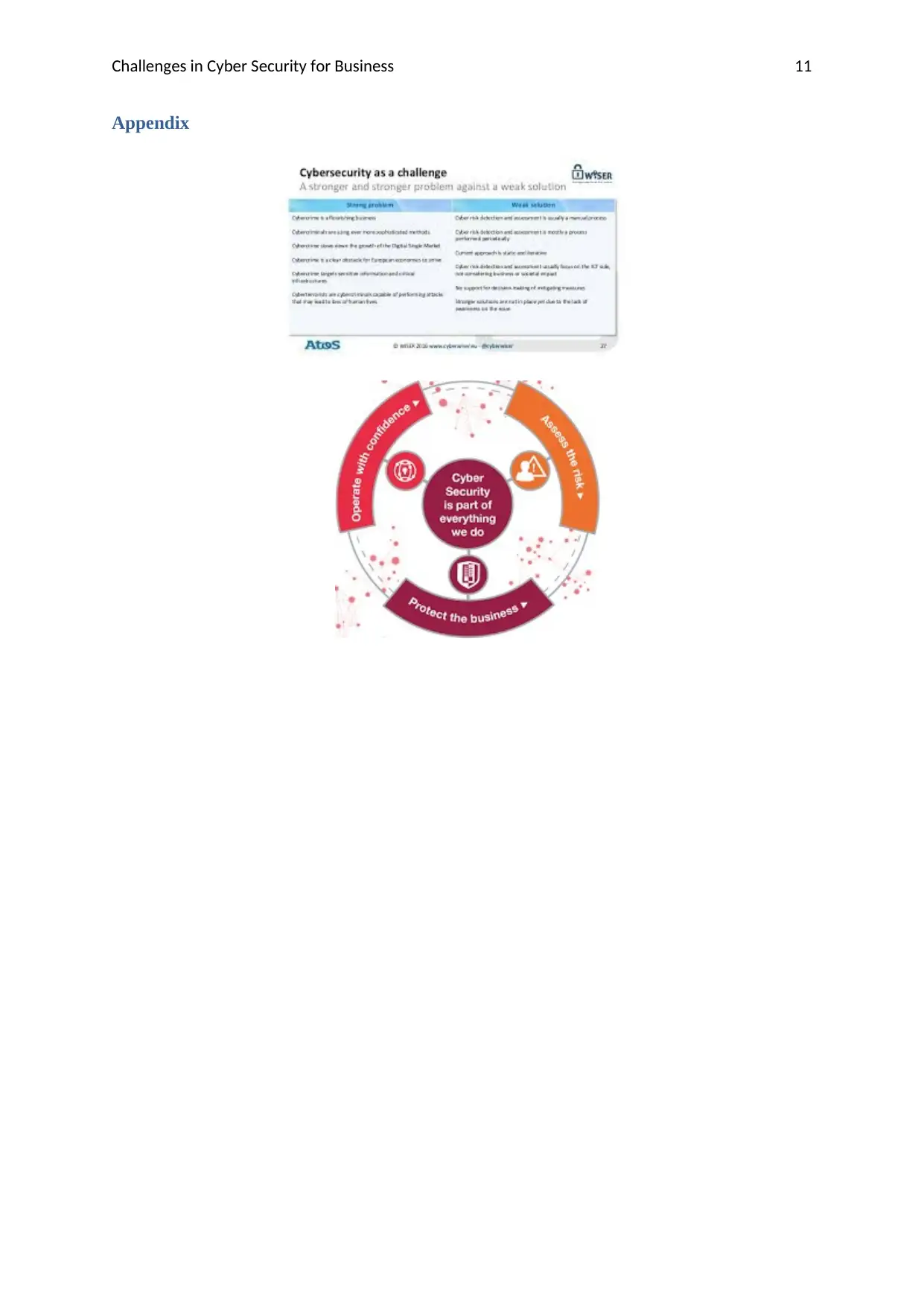
Challenges in Cyber Security for Business 11
Appendix
Appendix
⊘ This is a preview!⊘
Do you want full access?
Subscribe today to unlock all pages.

Trusted by 1+ million students worldwide
1 out of 12
Related Documents
Your All-in-One AI-Powered Toolkit for Academic Success.
+13062052269
info@desklib.com
Available 24*7 on WhatsApp / Email
![[object Object]](/_next/static/media/star-bottom.7253800d.svg)
Unlock your academic potential
Copyright © 2020–2025 A2Z Services. All Rights Reserved. Developed and managed by ZUCOL.





